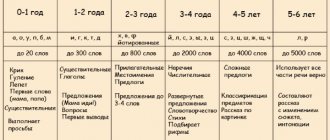Speech development is a very important process in the formation of the human body. Children begin to pronounce their first words at 11-12 months, and by 3 years they can already write sentences and a short story.
During this period, it is very important to ensure that the child’s speech develops correctly without any delays or disturbances. For this purpose, medical specialists have developed methods for diagnosing speech in children.
Methodology for learning vocabulary in children
The purpose of this test is to check whether the child has sufficient knowledge of words for the age of the child. His ability to quickly select the exact word, as well as create simple grammatical structures.
To diagnose, you need to take a group of any pictures of 10-15 pieces with animals, plants, fruits and vegetables, toys and transport.
There should be no more than 30 cards in total. The adult tells the child one general word denoting the group of pictures that he is going to show. The child must say that he is part of this group and select pictures according to the diagram.
After completing the task, the person must count how many pictures the child chose correctly. For one card he will receive 1 point.
High level – 25-30 pcs.
Average level – 10-25 pcs.
Low level – up to 10 pcs.
It is important to select age-appropriate cards. Pictures of everyday things are best. For example, in the animals section there can be cats, dogs, birds, hares and mice. That is, what the child has already seen in his life.
What are the goals of diagnosing speech development?
The question of why this is necessary is often asked by parents to teachers in kindergartens. As a rule, adults are confused by the wording that involves the word “diagnosis.” Accustomed to attributing this term to the medical field, many believe that diagnosing the speech development of preschool children is something like a verdict and are afraid that someone will put a kind of stigma on their baby.
In fact, the techniques pursue completely different goals. During speech diagnostics, the following skills are identified:
- accuracy and appropriateness of words used;
- understanding the meaning and meaning of what is being said;
- mastery of declensions and other changes in the forms of parts of sentences;
- the ability to choose expressions that are similar and different in meaning;
- difference in shades of meaning in polysemantic words;
- the degree of orientation of the spoken word to convey meaning, description.
That is, the main goals of diagnostic methods are to formulate an individual task for the speech development of preschool children. In other words, these techniques identify strengths and weaknesses in a child’s speech and help parents and kindergarten workers identify the areas needed for the optimal development of a particular child.
Methodology for testing children's vocabulary, grammatical skills and vocabulary
The purpose of the diagnosis is to determine whether the child pronounces sounds correctly. Uses words. Does he have the right associations with the presented word? Tests the child's vocabulary.
To check, the adult must ask the child questions on different topics. For example, “What does the word ball mean? (apple, car, toy) Do you have this item at home? What is he like? Where did you get it from? What are you doing with it?
High level – the child clearly answers questions. Names examples and actions with the subject. He comes up with a short story about the thing.
Intermediate level – names an object and describes it only superficially. Individual words or phrases.
Low level – Names 1-2 words.
Next, the adult names the objects or their signs, and the child must choose the correct word for them, the opposite in meaning. In this way, a person will understand whether the child correctly understands the essence of the word. For example, the word “long” is called. The answer should be “short”. Light dark. Fast - slow, etc.
Tall – correctly names opposite words.
Medium – selects words with a negative particle “not”. Not light, not long.
Low – does not always or incorrectly name words.
What to do if your baby's speech is low
The relativity of the criteria that guide preschool workers is obvious even to people far from pedagogy. Therefore, you should not get upset, much less argue with the teacher. It is necessary to find out in detail what exactly the child failed to cope with during the diagnostic tasks.
For example, if diagnostics of the speech development of preschool children revealed that the child cannot find antonyms or synonyms for a word, then it is worth doing just that with him. Things are much more complicated in situations where teachers use so-called “fashionable” methods, in other words, thematic ones. For example, those based on oral folk art and folklore. The results of testing children using such specific methods are not only controversial, they almost always do not correspond to reality. If a teacher in a preschool institution is going to use such diagnostic materials, then he must first work with the kids - introduce children to folklore, analyze proverbs and sayings, explain the meaning of riddles.
For example, the well-known riddle about a girl in a dungeon who let her braid out into the street. A modern urban child, without prior explanation, is not able to guess that we are talking about carrots. For a child, this vegetable appears from a store or from a market stand, and not from underground. And there are a lot of similar nuances.
Methodology for testing phonetic speech development
The goal is to identify the correct pronunciation of sounds. An adult needs to understand whether the child understands the differences in sounds and whether he can distinguish them from each other.
First, the adult checks to see if the child can pronounce each letter in the alphabet correctly. To do this, he can use a pre-prepared table. If the child does not yet know how to write letters, then you can tell him the words and ask him to repeat.
High – all sounds are pronounced correctly.
Medium – sounds are pronounced correctly, except for hissing or sonorant ones.
Low – there are errors in the pronunciation of many sounds.
Secondly, the person shows the child pictures of objects. These can be the simplest groups of words. The main thing is that the child knows them well. An adult should ask to select and pronounce cards that have a sound, for example, “l”. You need to do the same with other sounds. It is preferable to choose sonorous and sibilant ones, because Children most often have difficulty pronouncing them.
High y – correctly selects pictures for all named sounds.
Medium – selects only 2-3 cards.
Low – indicates only one picture or does not indicate at all.
The final step is to check whether the child distinguishes the intonation of pronunciation and whether he can speak with it.
The person asks the child to pronounce any phrase with different intonations. For example, I'm going to the zoo. It must be said in surprise, joyfully and questioningly.
High – correct pronunciation of the sentence
Medium – only 2 intonations are correctly conveyed.
Low – can only read in narrative
line or 1st of the proposed intonations.
What is important for diagnosing its development in children?
Diagnosis of speech development in preschool children is carried out on the basis of assessment of individual properties characterizing verbal activity.
The properties of speech that you need to pay attention to are:
- content;
- understandability;
- expressiveness;
- effectiveness.
Content is a characteristic that allows us to judge how clearly a child expresses thoughts and their quantity. About the significance of aspirations, desires of feelings and their correspondence to reality.
Understandability of a child’s speech means not only its intelligibility and correct pronunciation of sounds. Within the framework of this characteristic, we also consider how exactly the baby constructs sentences, whether he emphasizes words, and whether he uses pauses. That is, this characteristic includes the ability to place logical emphasis and emphasize the semantic meaning of a phrase.
Expressiveness is the emotional richness of children's speech. This characteristic also includes such concepts as the variety of linguistic means used. Effectiveness is the intelligibility of what is spoken, the impact of speech on people.
Method of testing coherent speech
The goal is to identify the ability to logically construct sentences. Build a small narrative.
The person offers to describe the object in the picture or choose from the surroundings. For example, your favorite toy, bear or table.
High – creates a correct description of objects. The story is divided into 3 logical parts with a beginning, middle and conclusion.
Medium - describes only some external features of the object.
Low – names individual words and small phrases.
Average level of speech development
The main problems of speech development in preschool children, the identification of which allows teachers to talk about the average level, are as follows:
- when presented with a word with the task of making a phrase with it, the baby completes it with only one epithet;
- copes with the choice of antonyms or synonyms, but pronounces them in the wrong case or declension;
- incorrectly pronounces individual sounds, which causes difficulties in understanding what is being said;
- in case of errors in test execution, he corrects them with the help of guiding questions or other hints.
Thus, almost any child can demonstrate an average level of speech development, without any special training with him. However, difficulties may arise for those children who are not particularly active in communication and are prone to shyness and anxiety. Often this is the reason why a child copes with tasks with average rather than excellent results.
Methodology for general testing of speech development
In this diagnosis, a person checks whether the child can independently change the forms of words, whether he correctly understands their meaning, and whether he can construct various sentences. Does his association of objects with other things work correctly?
To do this, an adult thinks of a simple word. For example, a wolf, a fox, a doll, a car, etc. The child should ask leading questions. Asking for a description of the item. What does he look like? What size is it? Does he have it at home?
High – guesses all the words correctly.
Average - can guess only 1. Or all, but with more clues.
Low – cannot guess the word.
Many parents do not diagnose speech development in their children at home. Although the developed methods allow this to be done. A large number of diseases and abnormalities can be detected through diagnosis in the early stages and the child can be helped in time.
Related posts:
- Inflection skills in children with ODD - diagnostic methods Diagnosis of inflection skills in children with ODD - methods and...
- From experience in diagnosing and forming creative imagination Research on creative imagination - diagnosis and its formation in children...
- Experimental study of the development of coherent speech in preschool children with ODD. Diagnosis of coherent speech in children is carried out using accessible...
- Supporting the process of development of coherent oral speech in children with special needs Psychological and pedagogical support of the process of speech development in children with speech disorders….
Theories and methods of speech development in preschool children
Studying speech is an important part of the educational process and the mental education of a child. Language proficiency is considered an important criterion for readiness for the school curriculum.
In accordance with the Federal State Educational Standard, preschool methods of speech development should be aimed at achieving the following goals:
- formation of free communication of children with each other;
- vocabulary development;
- hearing development;
- studying literature.
Development methods in preschool educational institutions
Methods for teaching speech development should be aimed at achieving the child’s ability to freely express his thoughts and desires, maintain a conversation with both peers and adults, and develop creative skills and abilities.
Types of modern techniques
There are a large number of modern methods of speech development. Most often, work in kindergarten is based on methodological textbooks by V. I. Yashina, M. M. Alekseeva and L. P. Fedorenko.
The theory and methodology of speech development in preschool children by the authors Yashina and Alekseeva are popular due to the clear phasing of tasks. The program includes the following:
- vocabulary replenishment;
- formation of competent perception of sounds;
- development of skills to construct sentences;
- teaching connected storytelling.
Modern methods involve the active use of visual techniques, showing paintings, photographs, and conducting conversations. Theatrical skits and drawing lessons play a big role in the development of speech in preschoolers. In older groups, the focus is on identifying violations and correcting them.
Forms of training
Stages of speech development
Knowledge of the world around us begins from birth. It is during this period that the foundations of speech are laid. A child's first conscious words can be heard at the age of one year. The accumulation of vocabulary begins and pronunciation improves. Every day the baby will reveal something new.
At the age of three years, the baby pronounces simple sentences, he is able to talk about what he saw and express his desires. By the age of five, the vocabulary is actively expanding, children sing songs and recite poems.
Stages of development
Speech development methods
The method of speech development in pedagogy is understood as a method of activity of a teacher aimed at developing speech skills.
Methods and techniques are classified depending on the materials used in the work and the nature of cognitive activity.
Do parents in kindergarten need consultations on speech therapy?
There are three main methods:
- visual;
- verbal;
- practical.
Many teachers consider this division to be conditional, since there is no clear boundary between them. All three methods should work interconnected.
In kindergarten, visual methods are most often used. They are divided into indirect and direct. The second group includes excursions and inspections of premises. Activities are aimed at accumulating vocabulary.
Verbal methods include reading fiction, memorizing poetry, and retelling. This should be accompanied by visual techniques, since preschool age necessarily requires visualization.
Practical methods consist of the use of didactic materials, games, and performances of skits.
Basic methods
What methods are used in diagnosis
Methods for diagnosing the speech development of preschool children are constantly being developed and their number is quite large. Each preschool institution has the right to choose for itself a set of teaching materials and manuals. For this reason, those parents who want to be aware of how their child will learn and what will be used to diagnose the degree of development of his speech should contact the teachers or the head of the kindergarten directly.
As a rule, the methods of the following authors are used in diagnostics:
- F. G. Daskalova;
- O.S. Ushakova;
- EAT. Strunina;
- O.A Bezrukova;
- HE. Kalenkova;
- E.S. Zaitseva;
- VC. Sheptunova.
Of course, the list of teaching aids is not limited to the works of these teachers; in a particular kindergarten, they can also be guided by tests of other authors.
What do methods of speech development for children that meet state standards include?
Technologies for the speech development of preschool children are activities with them, both in educational and playful forms. The closer the onset of school age, the greater the priority given to classes conducted in the same way as a regular lesson.
Methods that include the following areas comply with federal standards:
- development of oral speech skills;
- replenishment of active vocabulary;
- development of monologue speech and the ability to conduct dialogue;
- the concept of speech creativity and its basics.
In addition, the teaching materials used by teachers may contain sections devoted to the development of skills in intonation, logical stress, sound and phonetic culture.










